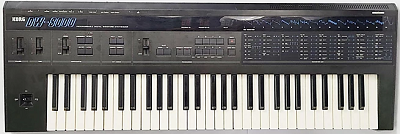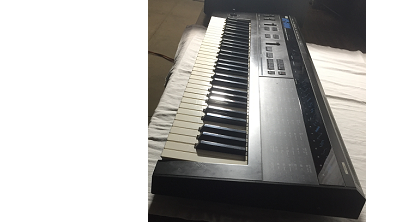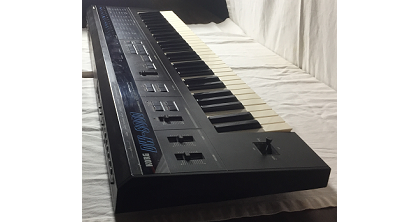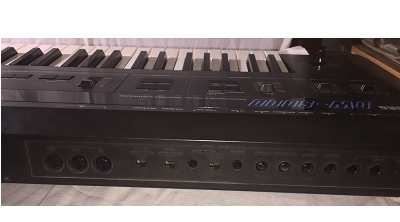Korg Programmable Digital-Waveform Keyboard
$775.00

Model# DW-8000
Eight-Voice Polyphonic Hybrid Digital-Analog Synthesizer 61-note Keyboard Instrument
Programmable Digital~Waveform Synthesizer Keyboard with a sound file upgrade (80s Rock & Roll library). A very cool rich stereo sound comes from this 1985 keyboard.
This board had inspired a new bass tone craze in 1980s music, sound voices were triggered from outside controllers using midi from drum pads or layered with other keyboard, great for playing solo~leads. Has eight polyphony sound with 61 keys (with initial touch and after touch) 64 program memories digitally controlled analog hybrid synthesizer. It also featured 8 digitally sampled waveforms, an all analog resonant filter and 8-voice polyphony of 2 per voice that could be stacked for a large stereophonic sound. Much more voicing, routing, and waveforms to many to list here, come with additional sound library, foot pedal, manual and power cord all included.
Just wait until you here the Edgar Winter Frankenstein song hook effect I made for yourself (very cool)
HISTORY
The Korg DW-8000 synthesizer was released to the buying public in late 1985 along with the cheaper DW-6000 synthesizer. The DW-8000 was an eight note polyphonic hybrid digital-analog synthesizer instrument. By the time of its launch Korg had already begun a common trend in 1980s synthesizer design of using numerical parameter access as with the Korg Poly-800 eschewing the heavily laden control panels of earlier designs. A more unusual feature of the instrument for the time was the use of sampled waveforms as the basic building block of sounds and the inclusion of a digital delay effect. This latter feature was a significant factor in the relative success of the DW-8000 compared to the DW-6000 released the same year.Physical Characteristics:
The instrument used a 61 note synthesizer action keyboard that was velocity sensitive, and could sense channel pressure aftertouch as well, sending it via MIDI if required. A four way joystick was provided to control LFO modulation as well as pitch bend. Pulling the joystick bender towards you allowed control over VCF as well. On the back panel were headphones, stereo line outputs, and pedal inputs for damper, portamento, and program-up. Also available were two sockets for a tape interface to facilitate offline patch backup and storage. Electrical power was supplied via a two pin IEC C9 type connection cable rather than the more ubiquitous C13 type, which can potentially be a source of frustration if lost just before a performance.
Patch storage and backup:
The instrument had 64 memories which could be backed up to cassette tape in similar fashion to that used for home computers of the time. This system could be prone to error, as the availability of the ÒverifyÓ feature for the tape backup system can attest to. The instrument did however possess the capability in MIDI to allow sys-ex transfer provided you had another DW-8000 or a computer with suitable software that could send the MIDI dump request message to it. An optional accessory was the MEX-8000, a hardware device which could provide four extra storage banks to the user.
DWGS synthesis:
Sixteen digitized single cycle waveforms were available as basic sound building blocks to the user through a system Korg called DWGS for Digital Waveform Generator System. The DWGS system can simply be thought of as an early sample playback system where only short or single cycle waveforms are stored on four 256 Kilobit ROM chips, played back through the two DCOs and processed by relatively familiar subtractive filter synthesis facilities. The waveforms themselves comprised of the usual staple sine, sawtooth and pulse waveforms, but more unusually featured waveforms such as acoustic piano and saxophone. To aid the user in appropriate selection each of the sixteen wave samples are printed on the right hand end of the operating panel along with the parameter reference below. Any two of the digitised waveforms could be used by the two DCOs provided. A noise source could be added separately to add further color.
Oscillator modes:
The synthesizer could be used in two polyphonic modes and two monophonic modes. The latter monophonic modes are worthy of examination on account of sounds they can generate. Each of the two monophonic modes arranged the oscillators into a single note stack of slightly detuned oscillators. Use of these two monophonic modes changes the character of any given patch considerably, imbuing it with what could best be described as a powerful or fat sound.
Analog VCA and VCF stages:
While the source sounds were digital, the subsequent major sound shaping stages consisted of an analog VCA enveloper using six stages and similar arrangement for the analog filter. The filter is unmistakably analog and can be pushed into self oscillation using the filter resonance parameter. Further modulation of the sound could be applied using the single LFO which could either modulate the DCOs to produce vibrato effect or the filter, or even both at the same time. An important creative limitation of the DW-8000 architecture was that the user could not control the LFO depth with respect to each DCO; they were both modulated in common thereby losing some flexibility.
Digital delay effects:
The final key part of the architectural jigsaw was the digital delay section. As the rest of the synthesizer architecture up to this point in the sound chain was analog, the signal had to be converted back to a digital signal. This fact is evident as increased noise when using the delay effect. Despite this, it was a flexible digital delay that gave times ranging from 2 to 512 milliseconds in length. Added to this was a modulation depth parameter so the user could create chorus and flanging effects as well as delay.
Arpeggiator section:
In 1985 synthesizers with built-in sequencing facilities were quite rare, however the DW-8000 did have a 64-note arpeggiator section. The 64 note memory could be especially useful when the arpeggiator was set to its assignable mode. This allowed the arpeggiator to loop around any number of notes up to 64 that the user added to the arpeggio. The arpeggiator can be set to latched mode so that the sequence continues to play after the user releases the keys, or un-latched mode where the sequence will immediately stop when keys are released. A facility to make the arpeggio span one or two octaves, or even the full keyboard can be selected. Finally a tempo slider sits immediately to the left of the arpeggiator controls to control the speed of the arpeggiator sequence.
Historical assessment:
The DW-8000 in itself cannot be seen as a huge milestone or breakthrough product, but the hybrid architecture of samples partnered with subtractive synthesis was to become an important motif in Korg keyboards during the latter half of the 1980s. Other manufacturers whether knowingly or not were soon arriving with instruments using similar ingredients of samples and effects but still using traditional subtractive filter synthesis, only with better technology. The Korg DW-8000 was not multitimbral and would therefore not fare well in the market that only two years later would produce both the Roland D-50 and MT-32 which used samples of real attack transients to create increased realism whilst the MT32 also brought multitimbral facilities with relatively high quality effects. Korg themselves took longer to find the winning combination and by the end of the decade had hit considerable success with their M1 workstation which itself included a few old DWGS samples.
Used – Good
Same Day Shipping - Ships from Blonds personal stash
Located in: New Orleans, Louisiana, United States
Handling Cost:
$20.00 will be added on items over 30lb
$50.00 will be added on items over 100lb
Free local pickup
Shipping: Calculate
make an offer



